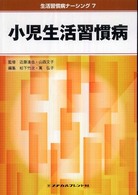- ホーム
- > 洋書
- > 英文書
- > Nature / Ecology
Full Description
Originally published in 1966, the extremely urgent task confronting our generation - to produce food in sufficient quantity and of adequate quality for the world's rapidly increasing population - may have appeared terrifyingly great and very difficult to solve. In fact, some regarded it as impossible, visualising a world in which the population would increase quicker even than scientific man could feed it and seeing a solution only in wholesale birth control.
To these Hugo Osvald, a Scandinavian nutrition expert, did not belong. He surveys all the means, scientific and agricultural at our disposal at the time and reveals that, by their rapid development, enough food can be produced for a world population several times larger than at present. There are practically no limits, he said, to the possibilities of producing food. We were utilizing only a small percentage of the earth's capacity.
Even the lands where starvation was prevalent have the same basic necessary conditions for a vast improvement: fertile soil, water and labour. Knowledge and guidance were already available and could be increased. Dams, irrigation systems, transport facilities and power supplies, fertilizer factories, plant breeding and protection, animal husbandry, technical education - all these could be provided and the possibilities of the oceans as a source of supply had scarcely been explored.
The author considered all these factors and the problems involved, and brings a convincing answer to the pessimists. With food poverty still an issue today, this book can be read in its historical context.
Contents
Preface. Introduction. 1. Can the Earth Feed Us? 2. The Problem of Hunger Through the Ages 3. The Problem of the World's Food Supply 4. Personal Impressions of Distress and Suffering 5. Measures Against Famine 6. Population Trends 7. The Need for Help 8. Food Production or Birth Control? 9. How Much Does Food Production Need to Increase? 10. Can we Improve the Management of the Earth's Produce? 11. Ways of Increasing Food Production 12. An Increase in Efficiency Presupposes Education and Training 13. Food from the Oceans and Lakes 14. The Industrial Production of Foodstuffs 15. The Supply of Energy 16. The Need for Aid. Different Forms of Assistance 17. Food Supply, Disarmament and World Peace 18. Conclusion. Index.







